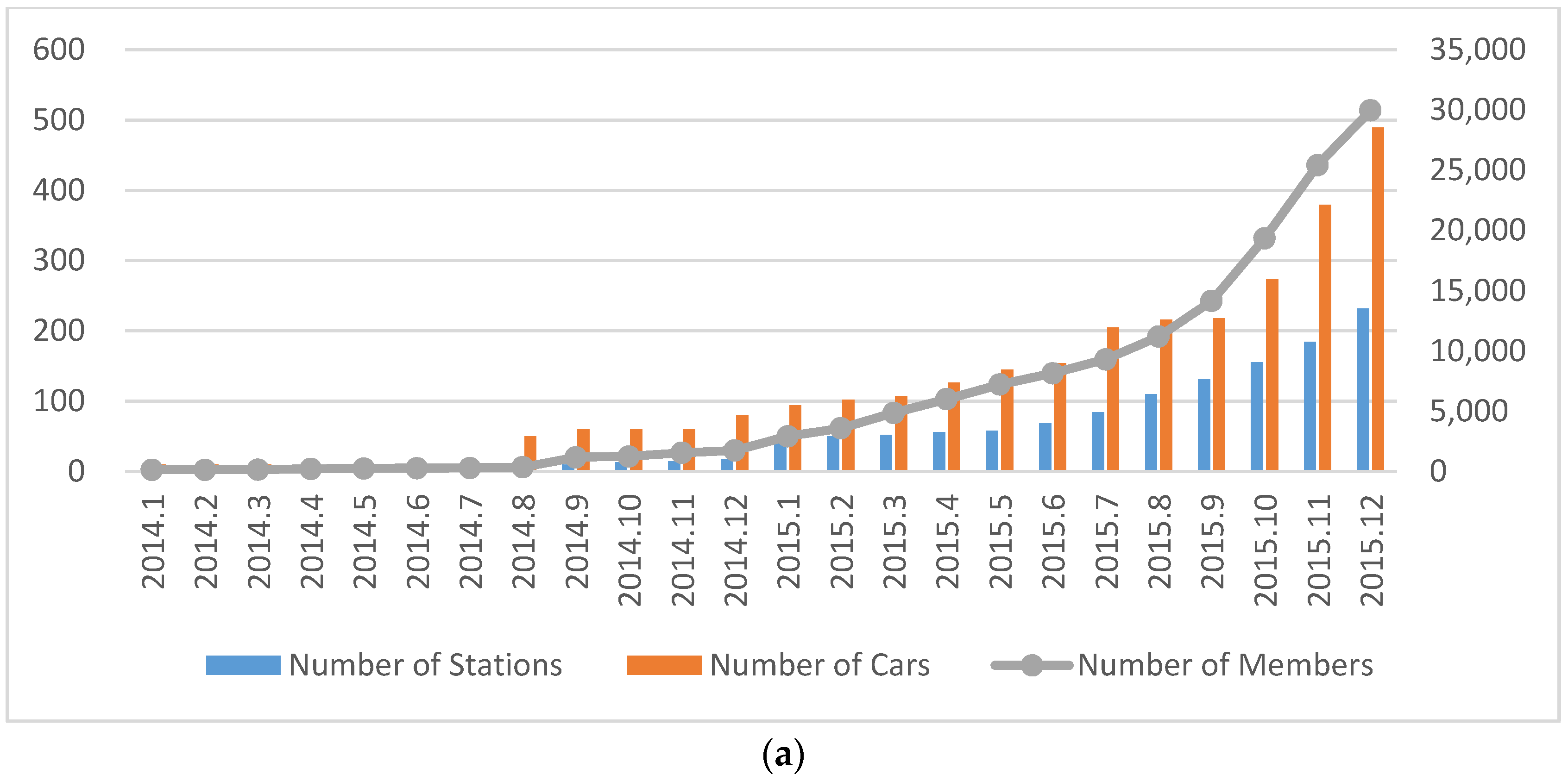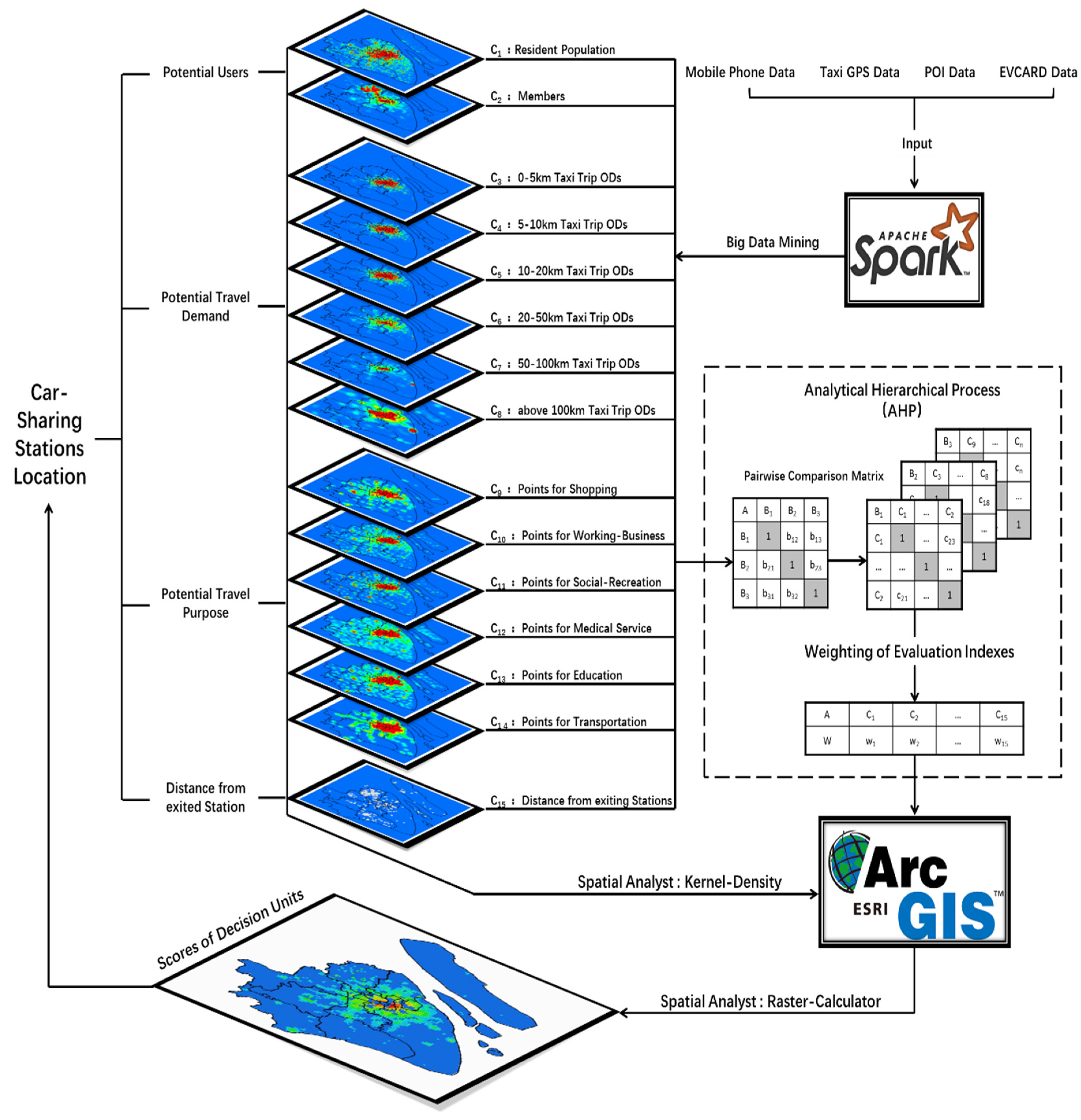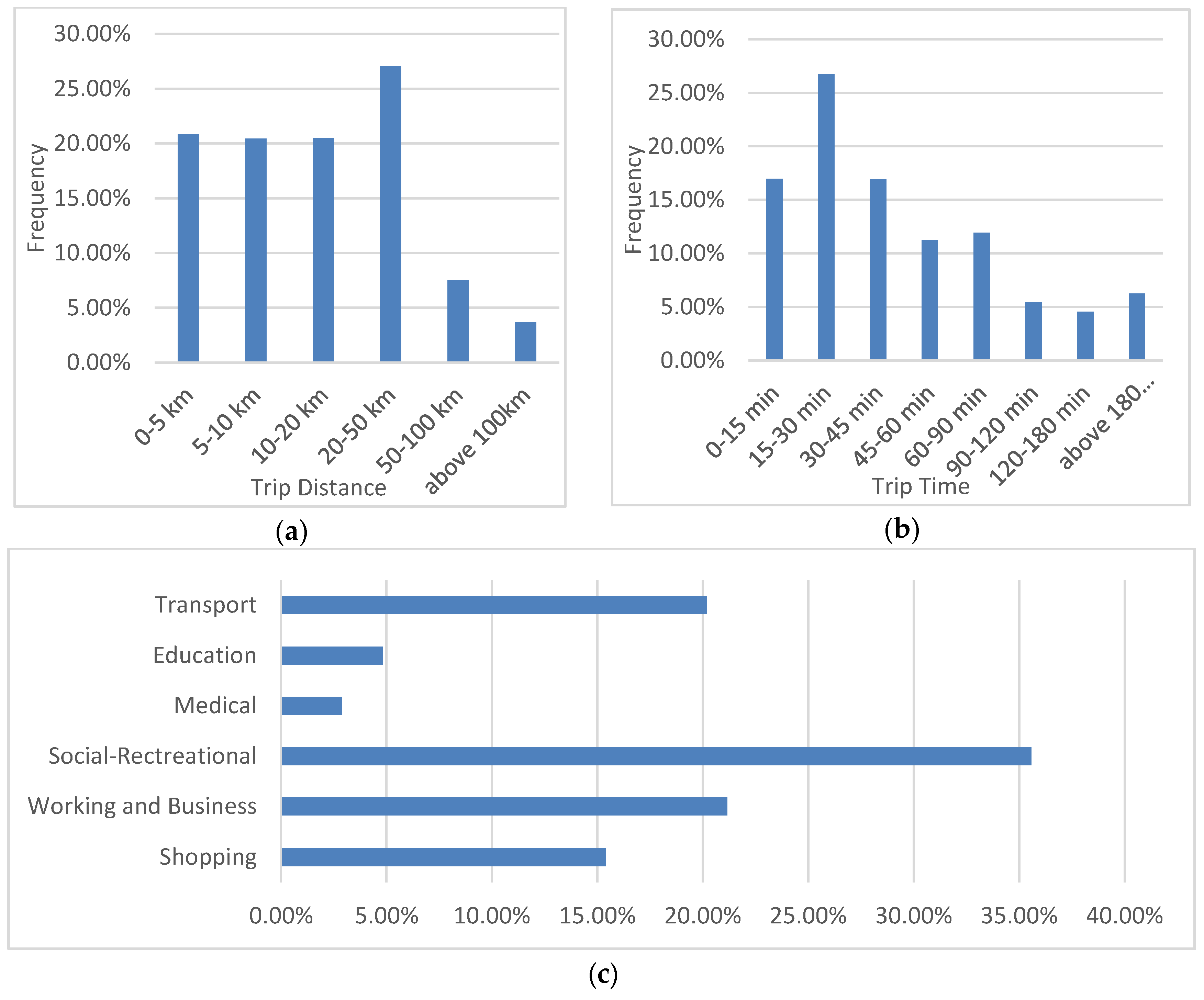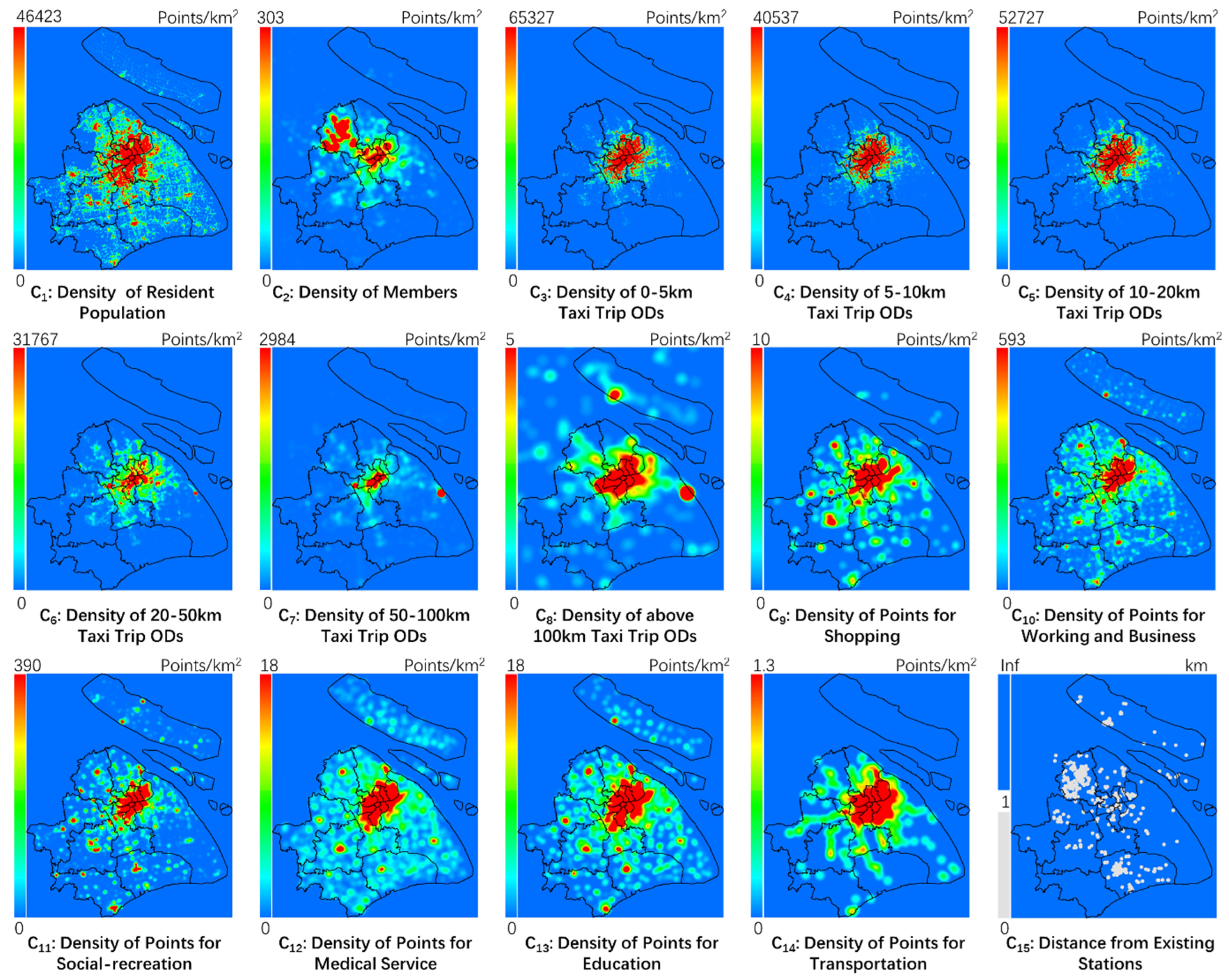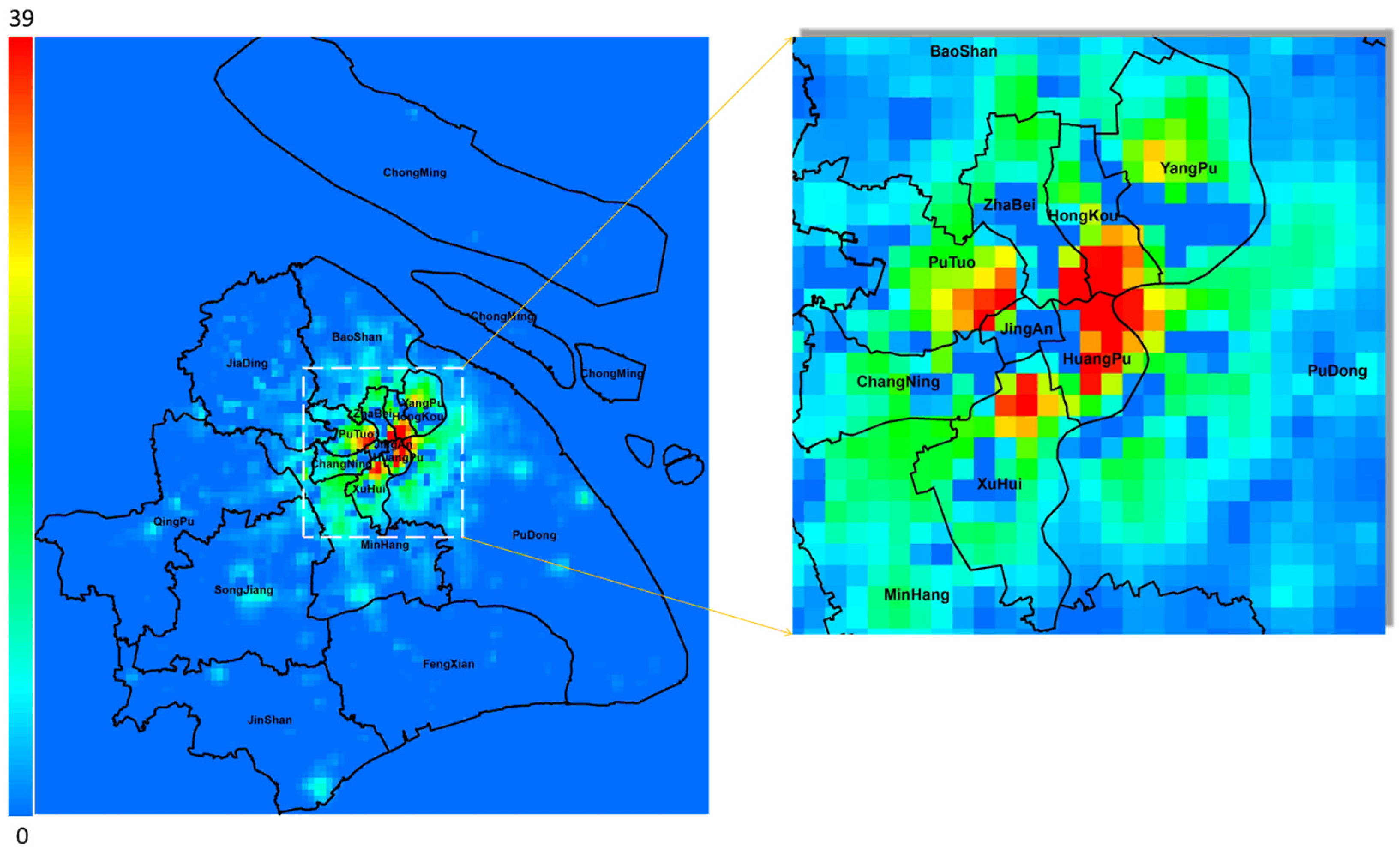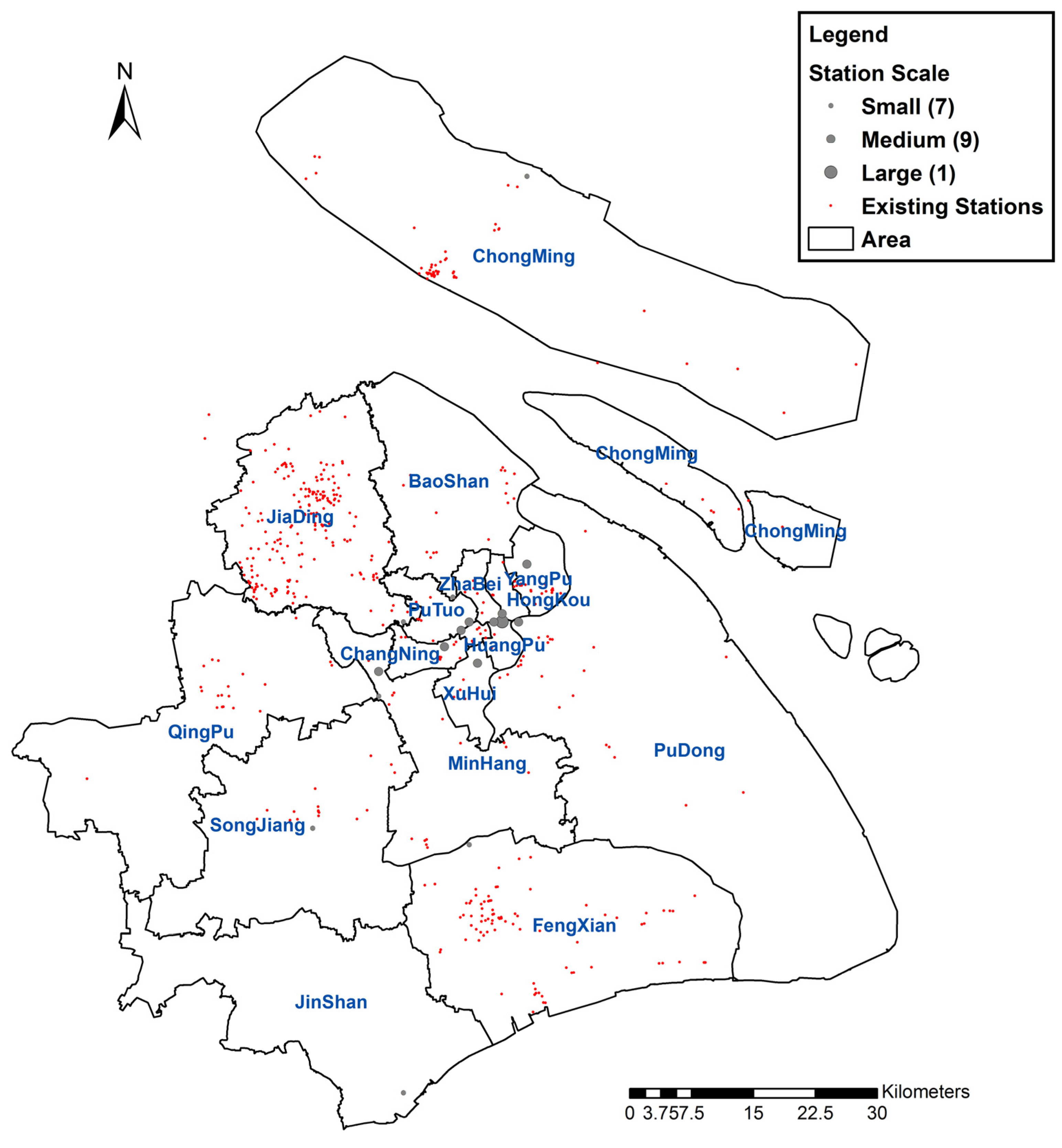1. Introduction
With the development of the automotive industry, the problems of traffic jams, parking difficulties, and air pollution become more and more serious. Carsharing, which aims to reduce vehicle ownership, vehicle kilometers traveled (VMT), and greenhouse gas (GHG) emissions, is considered to be one of the effective ways to relieve the problems [
1,
2,
3]. As of October 2010, carsharing was operated in more than 1100 cities, in 26 countries, on five continents (Asia, Australia, Europe, North American, and South America) [
2]. By 2014, the number of members reached 4.94 million and the number of shared vehicles reached 92,200 [
4].
In a broad sense of meaning, carsharing refers to an innovative type of business based on the shared use of cars, which provides access to cars without actual ownership [
5]. Although there are different kinds of options for carsharing, most carsharing systems are often designed for shorter time and shorter distance trips as an extension of the transportation network. From the perspective of parking location, carsharing systems can be divided into free-floating systems and station-based systems. Free-floating systems allow vehicles to be picked up and left anywhere within a designated operating area, while station-based systems require users to return vehicles to an available station [
6]. Furthermore, station-based carsharing systems are also classified into one-way and round-trip types, according to whether users should return a rented vehicle at a different location or at the station they picked it up. Comparing both systems, free-floating systems are more flexible but cannot be reserved in advance, whereas station-based systems provide users with the ability to make reservations but require more planning and consciousness [
7].
This paper mainly focuses on the one-way station-based carsharing systems, where station siting is one of the greatest challenges and long-term decisions, because it has direct impact on the quality, efficiency, and cost of the service, and also affects profits and market competitiveness [
8,
9]. Therefore, the objective of this paper is to establish a station siting decision system supporting the electric carsharing program EVCARD in Shanghai, China. Since multi-criteria decision making (MCDM) methods are widely used in the site selection process, the following studies can make contributions to this problem.
MCDM is a branch of a general class of operations research models which deal with decision problems under the presence of a number of decision criteria [
10]. It can be implemented by various techniques such as weighted sum method (WSM), weighted product method (WPM), analytical hierarchy process (AHP), preference ranking organization method for enrichment evaluation (PROMETHEE), elimination and choice translating reality (ELECTRE), technique for order preference by similarity to ideal solutions (TOPSIS), compromise programming (CP), and multi-attribute utility theory (MAUT) [
10]. Recently, to address the uncertainty and complexity arising in the decision-making, some new methods have been developed combining MCDM with fuzzy logic theory, like fuzzy AHP, fuzzy comprehensive assessment, and fuzzy TOPSIS [
5,
11].
Among these methods above, AHP is the most popular method and the most widely-used multi-criteria tool in transportation planning [
12]. The strength of this approach is that it organizes tangible and intangible factors in a systematic way, and provides a structured, yet relatively simple, solution to the decision-making problem [
13]. Awasthi et al. present a multi-criteria evaluation approach based on the AHP for carsharing station selection [
13,
14]. The population density, parking difficulty and cost, mix of land use, presence of target groups, transit/multimodal access, and vehicle ownership are chosen as decision criteria. However, the limitation of this method is that the candidate stations must be selected at first. Normally, it is very difficult for carsharing operators to determine candidate stations. For example, Celsor and Millard-Ball assess the market potential of carsharing in urban neighborhoods by analyzing neighborhood characteristics of existing carsharing locations, which can be used for determining candidate stations [
15]. To sum up, the studies above cannot directly output an optimal location of a carsharing station without candidate solutions.
On the other hand, there are some researchers using mathematical optimization models to obtain the optimal solution. Correia and Antunes propose the mixed-integer programming (MIP) models to depot locations in a one-way carsharing system [
16]. The objective here is to maximize the profits of a carsharing organization considering all revenues and costs involved. Advanced branch-and-cut algorithms are employed to solve the MIP problems. Further, the solutions are tested using a simulation model which considers demand variability and a vehicle relocation policy [
17]. The results reveal that both demand variability and relocation operations have significant impact on solutions. In addition, Kumar and Bierlaire build a multi-linear regression model to identify drivers of carsharing demand and then use a mixed-integer programming model to optimize the station location [
18]. Although these optimization models can provide some optimal locations, they are not applicable to large-scale planning since finding solutions takes a lot of time, and global optimal solutions are hard to obtain.
In summary, most previous works are based on theoretical models or simulations without taking real demand into account. To predict carsharing demand and determine station locations, Zhu et al. propose a deep learning approach using three data sources consisting of taxi GPS data, points of interests (POIs), and road networks in Beijing [
8]. Taxi origin and destination (OD) points are used to represent the potential demand, and POIs determine candidate stations. This approach seems to be more efficient and scientific for siting decisions using real data. However, trip ODs corresponding to different distances and POIs with different categories have different impact on the demand for carsharing, and this fact is ignored in their study. In addition, using single criterion to determine candidate sites is inadequate.
To cover the shortages of existing research, this paper employs a method combining the analytic hierarchy process (AHP) and geographical information system (GIS) to determine the location of carsharing stations. This method can be applied as a multi-criteria decision analysis instrument in different fields, such as engineering and planning [
19]. It is proved to be efficient and practical for location selection of landfills [
20,
21,
22,
23,
24], solar farms [
25], incineration plants [
26], transit alignment [
27], and purpose-built offices [
28]. However, it has not been adopted for carsharing station siting yet. Therefore, we introduce this method in a case study of the Shanghai EVCARD to verify its effectiveness for carsharing station siting. More specially, big data mining is incorporated in this method.
2. Case Description
This research considers the EVCARD, China’s first electric carsharing program, operated by Shanghai International Automobile City Corporation as the case study. It is a one-way station-based carsharing system. Three types of cars can be rented currently, namely, Roewe E50, Chery EQ, and Zinoro 1Es. Registered members of the EVCARD can check the availability of electric cars nearby and book one via an application on a smart-phone. Then, the booked car can be unlocked by swiping a smartcard or issuing an order in the application. Recharging services are available at every station. The rental period can be as short as several minutes. Each minute costs 0.5 CNY for Roewe E50 or Chery EQ, with the daily maximum of 180 CNY, and 1 CNY for Zinoro 1Es with the maximum of 360 CNY per day.
Since the project launched in December 2013, both the demand and supply of the EVCARD developed rapidly. The growth trends of stations, cars and members during 2014–2015 are shown in
Figure 1a. The cars-to-station ratio is around 2:1. However, the members-to-cars (or stations) ratio is increasing. By June 2016, the number of registered members has reached 89,129, while only 474 stations have been set up in Shanghai. The spatial distributions of members’ addresses and stations are shown in
Figure 1b. It can be seen that most of the stations are in JiaDing District and FengXian District, far away from center area of the city. At the same time, the growth of membership is limited by the stations’ locations, where most members gather around the existing stations. Therefore, the EVCARD is expected to expand its service area towards the center district of Shanghai to attract more users and meet higher demand. How to properly site future stations is the problem addressed in this paper.
4. Results and Discussion
Applying the method and data presented above, the synthetic scores of every decision unit for the siting of carsharing stations are presented in
Table 6. Based on the mapping relation between UID and the location of decision unit in GIS, the scores of the decision units can be visualized using a heat map where the red color represents the highest scores and the blue color represents the lowest scores, as shown in
Figure 5. The results show that high-score units are distributed in the center of the city, mainly in the north of HuangPu District, south of HongKou District, north of XuHui District, and east of PuTuo District, where there are more potential users, higher potential travel demand, and more points attracting people with different purposes according to
Figure 4. Therefore, these areas are the prior locations for siting of EVCARD stations. However, there are some exceptions in JingAn District, which is considered to be the downtown area. Since JingAn District already has seven stations located in an area of 8 km
2, there is less need to set up new stations in this area.
On the other hand, to expand the coverage and improve accessibility of carsharing, stations should be distributed more dispersedly instead of just in the center district of the city. There are 17 administrative districts in Shanghai. The operators of EVCARD usually consider how to add a station to each district separately. Given the scores and locations of all decision units in
Table 6 and
Figure 5, the top-score unit of each administrative district can be selected. For example, the top score of HuangPu district is 40.4039, which links to the No. 4225 unit. Then the carsharing operator should give priority to available land in this unit for building the next station. Accordingly, the stations proposed to be set up in the 17 districts of Shanghai can be marked in the map as shown in
Figure 6. Further, we divide the stations into three classes based on the score of the decision unit: small stations with 3–5 parking lots, medium stations with 5–10 parking lots, and large stations with 10–20 parking lots. As
Figure 6 illustrates, the size of the point on the map represents the scale of the station. It is suggested that a large station should be set up in the north of HuangPu District, 9 medium stations be distributed in downtown districts, and 7 small stations are needed in suburban districts. Furthermore, the dataset of indicator
C15 can be updated after applying the 17 stations to the locations of existing stations. In consequence, new stations can be planned continually.
We also analyzed the sensitivity of the results by changing the weights of the criteria and indicators. Within the change range of ±30%, the variations of score distribution were found to be very small. The center areas discussed above are always the prior locations for siting of carsharing stations, which indicates that the results of our method are stable and reliable. However, the areas selected by our method are ideally optimal locations for carsharing without considering parking spaces and land prices, which are changeable. In practical applications, more data regarding land use should be included. It is certain that the results can provide effective candidate sites for carsharing systems. If there is enough land for parking near a candidate site and the cost is acceptable, then the candidate site will be selected. This can save much time for decision-makers when siting stations for carsharing.
5. Conclusions
This paper is a case study of Shanghai EVCARD, an electric carsharing program in China. To determine the optimal locations of stations, a novel approach based on the AHP and GIS using multi-source data is proposed.
Firstly, this research selects potential users, potential travel demand, potential travel purposes and distances from existing stations as the decision criteria, and establishes a decision system with 15 evaluation indicators including the densities of resident population, members, travel ODs corresponding to different distances, and different categories of POIs. Second, data mining and preprocessing of mobile phone data, taxi GPS data, POI data, and EVCARD data are adopted to calculate effective values of the 15 indicators. Then, the AHP method is used to determine the weights of these indicators. The density of members turned out to be the most important indicator determining the location of the station. Additionally, the range of 20–50 km is the most frequently used distance in carsharing. In addition, the points for social recreation have a higher impact on carsharing than other POIs, while the points for medical purposes have the least attraction, since people tend not to choose carsharing in emergencies. Finally, the indicator values and synthetic score of every 1 km × 1 km decision unit are calculated using the spatial analysis based on ArcGIS. The results show that future stations should be set up in central areas of the city where there are more potential users and more potential travel demand with mixed purposes.
By integrating the methods of big data mining, multi-criteria evaluation, and spatial analysis, this research overcomes three obstacles of traditional location models, namely, that it is hard to obtain an optimal solution, select candidate sites and apply results in practice. This paper provides a more scientific, effective, and feasible way for carsharing operators to site stations, avoiding aimless and random decisions.
However, this research also has a few limitations. Due to the lack of land use data, the availability and cost of land to implement the station are not included in the decision system, which can be crucial aspects when deciding the locations. Additionally, travel demand of taxis may not perfectly represent the potential travel demand of carsharing, though they have many similar characteristics. With more data collected, other appropriate evaluation indicators can be added in the future. Furthermore, the number of shared cars deployed in each station should be discussed in future studies.
